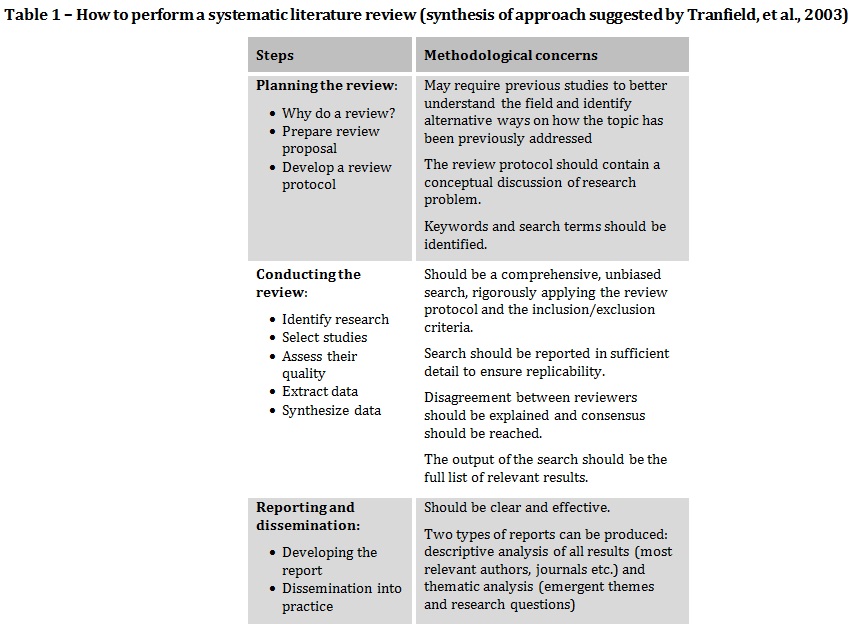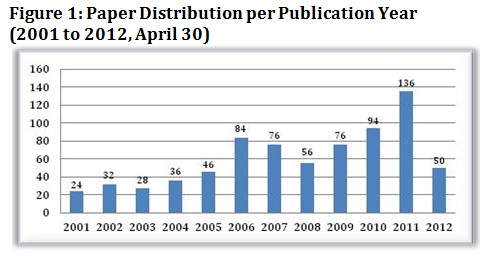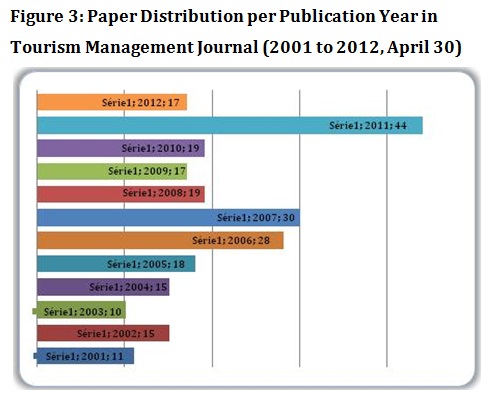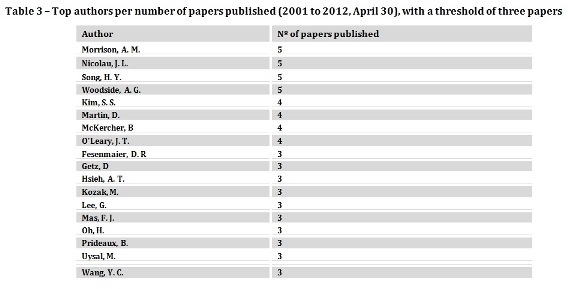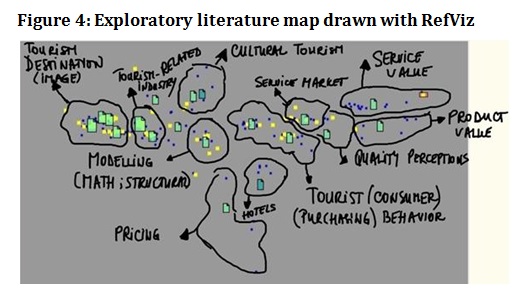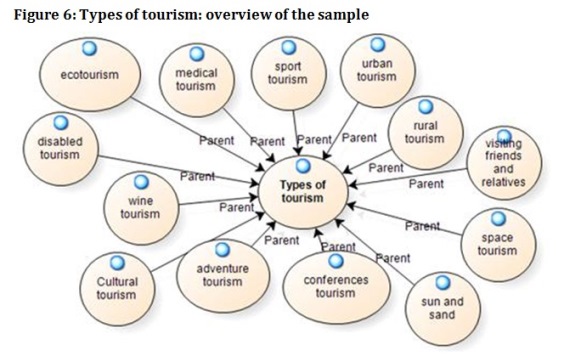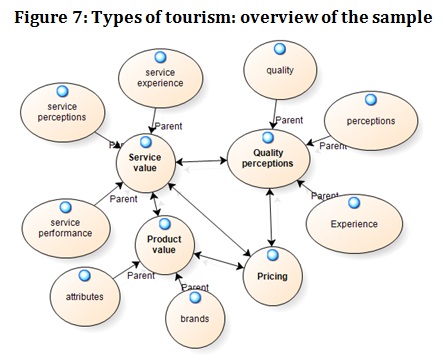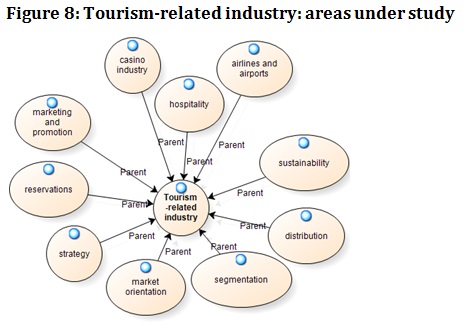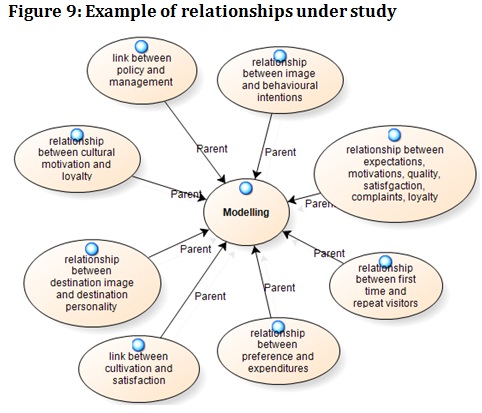Serviços Personalizados
Journal
Artigo
Indicadores
-
 Citado por SciELO
Citado por SciELO -
 Acessos
Acessos
Links relacionados
-
 Similares em
SciELO
Similares em
SciELO
Compartilhar
Tourism & Management Studies
versão impressa ISSN 2182-8458
TMStudies vol.9 no.1 Faro 2013
Linking past and future research in tourism management through the lens of marketing and consumption: a systematic literature review
Investigação passada e futura sobre gestão do turismo, marketing e consumo: uma revisão sistemática da literatura
Irina Saur-Amaral1, Pedro Ferreira2, Rosa Conde3
IPAM Lab, Research Unit in Marketing & Consumption @IPAM – The Marketing School.
1 rina.amaral@ipam.pt; 2pferreira@ipam.pt; 3rconde@ipam.pt
ABSTRACT
We perform a systematic literature review on academic papers in tourism marketing and consumption in ISI Current Contents. Based on 617 academic papers from 2001 to date, we perform content analysis in a grounded-theory methodological approach and map the field of tourism marketing and consumption, identifying main schools of thought (invisible colleges) and main players. We see a tendency to increase publications in 2007 and later in 2009. We identify key areas that developed in the most recent years and “dying areas”, emphasizing possible trends towards publications in tourism marketing and consumption in the coming years. We point out specialized international journals in this area (Tourism Management leads the game, by far, but also International Journal of Contemporary Hospitality Management, Service Industries Journal, and Journal of Business Research are well positioned).
Results benefit researchers in tourism management that wish to strategically focus their research in order to maximize publication and impact. They also benefit entrepreneurs/practitioners that wish to understand the expected evolution of the tourism management from an academic perspective, so as to subsequently develop more effective policies.
Keywords: Tourism, management, systematic literature review, state-of-the-art.
RESUMO
A revisão sistemática da literatura realizada analisou artigos científicos relacionados com marketing e consumo no turismo, indexados na ISI Current Contents. Com base em 617 artigos científicos publicados entre 2001 e 2012, foi aplicada uma metodologia do tipo grounded-theory para mapear o campo de estudo do marketing e do consumo no turismo, tendo sido identificados possíveis tendências de publicação nesta área. Foram identificadas revistas científicas especializadas (Tourism Management lidera com grande avanço, mas também aparecem bem posicionadas International Journal of Contemporary Hospitality Management, Service Industries Journal, e Journal of Business Research). Os resultados obtidos podem permitir aos investigadores na área de Gestão no Turismo o posicionamento estratégico das suas investigações de modo a maximizar as suas possibilidades de publicação e o impacto dessas publicações. Os resultados também podem ser úteis para gestores e fazedores de política que pretendem compreender qual a evolução expectável da área de Gestão no Turismo do ponto de vista académico, de modo a desenvolver práticas de gestão e políticas mais eficientes.
Palavras-chave: Turismo, gestão, revisão sistemática da literatura, estado da arte.
1. Introduction
In recent years, Tourism Management has seen several literature reviews in related subdisciplines, e.g. human resources management (Kusluvan et.al, 2010), innovation (Hjalager, 2010) and website evaluation (Law, Qi & Buhalis, 2010). However, there are few developments concerning the state-of-the-art focused on marketing and consumption in tourism, which is inconsistent with the remarkable growth of research in marketing and consumer sciences in the last decades.
Looking to fill this gap, we perform a systematic literature review on academic papers in tourism marketing and consumption in ISI Current Contents, using published scientific work to look back into the past and identified tendencies to anticipate the future.
We critically compare and aggregate existing contributions from scientific journals with impact factor from 2001 to 30th of April 2012 obtained from two separate searches on tourism, marketing and consumption in topic, which led us to an initial sample of 617 scientific papers.
Our paper is organized as follows.
First, we describe in the methodology chapter the relevant aspects for the systematic literature review: search protocol, search execution and filtering planning and procedures for content analysis of the relevant sample of scientific papers.
Second, we present the results obtained from the systematic literature review, including the search steps for transparency reasons, descriptive statistics on relevant sample (top authors, publication years, top journals), content analysis results and literature map with key identified schools of thought and key thematic areas of study.
We end with a discussion of the literature map and future research directions for academic scholars.
2. Methodology
The achievement of our research goal requires searching, filtering and analyzing a large amount of publications related to wisdom of crowds and its role in organizational innovation. This is a research task to be performed in the methodological underpinning of literature reviews and conceptual model building.
In the past decade, there have been quite a large number of academic studies focusing on meta-analyses, systematic literature reviews, structured literature reviews and so on (Briner & Denyer, 2012;Crossan & Apaydin, 2010; Denyer & Tranfield, 2009; Kofinas & Saur-Amaral, 2008 ;Pittaway & Cope, 2007; I. Saur-Amaral & Amaral, 2010; Walker, 2010).
However, researchers tend to use informal and unstructured processes to review literatures and decide upon the key areas to research ( Tranfield, Denyer, & Smart, 2003, see Table 1, page 213, for a very detailed perspetive over the process ), which necessarily leads to an incomplete process of identification of scientific school of thought and to low efficiency in the research process (Kofinas & Saur-Amaral, 2008; Irina Saur-Amaral, 2010, 2011). Systematic literature reviews are a systematic approach, with specific methodological concerns, which allow us to overcome this limitation.
In social sciences, the first adaptation of systematic literature reviews was done in 2002 and 2003 (Tranfield, et al., 2003; Tranfield & Mouchel, 2002). Tranfield and his colleagues proposed that systematic reviews should be used to develop decision-making evidence databases for managers, to overcome the typical unsystematic, informal and unconditioned process of literature review and to identify key areas to research. They suggested the methodological approach presented in Table 1.
In our research, we apply the three steps of systematic literature reviews, considering the experience of previous studies (Hjalager, 2010; Kofinas & Saur-Amaral, 2008; Kusluvan, Kusluvan, Ilhan, & Buyruk, 2010; Law, Qi, & Buhalis, 2010; Irina Saur-Amaral, 2011, 2012).
We first study the concept, then build the review protocol, based on keywords previously used by other authors. We rigorously perform the search according with the review protocol (see Appendix 1) and we record all the steps and justify decisions, ensuring transparency and replicability of the study. We extract records to Endnote X5, where we perform the preliminary relevance analysis and selection and we export relevant records to xml and then import into NVivo 9.
Descriptive data for generic and thematic statistical analysis is drawn from the classification sheet in NVivo 9.
We use RefViz to understand the sample and create the starting point for content analysis in NVivo, identifying themes of interest and positioning on the maps key authors and journals, as performed by Saur-Amaral (2012, forthcoming) when studying consumption articles published in impact-factor journals between 2001 and 2011.
We perform content analysis in NVivo, using as an orientation framework the keywords and the previous knowledge on the concept, yet drawing on categories building in a grounded-theory approach (Charmaz, 2006). We use queries to explore and test results, and we extract information via reports and specific matrix-coding queries, to support categories with specific number of references and citations.
The literature map is built upon the data obtained from content analysis and the explanatory descriptions of key themes and topics are supported by citations and references obtained from NVivo and RefViz analysis.
3. Systematic literature review
3.1. Search steps and filtering procedures
The search was performed on April 30, 2012, in two different moments (Search 1 and Search 2, which were afterwards combined with an OR operator).
Search 1 had as search equation “touris* AND marketing IN Topic”, Social & Behavioural Sciences (SBS) database of ISI Current Contents, with a timespan filter of publication date between 2001 and 2012 (date of search). We obtained 1300 results.
We next filtered on document type Article or Review and on subject area Business and Economics. We obtained 472 results.
Search 2 had as search equation “touris* AND consum* IN Topic”, Social & Behavioural Sciences (SBS) database of ISI Current Contents, with a timespan filter of publication date between 2001 and 2012 (date of search). We obtained 790 results.
We next filtered on document type Article or Review and on subject area Business and Economics. We obtained 252 results.
We combined the two searches using Search History functionality in ISI Current Contents, so as to ensure there were no duplicates records in the final sample. Search 1 OR Search 2 gave us a starting sample of 617 articles, which was our working sample, exported to Endnote X5.
From Endnote, we created the Subject Bibliography with abstracts, organized by publication years. All three researchers performed separately the relevance analysis, reading all abstracts and putting aside those that were not related with marketing or consumption in tourism, according to our initial research goal.
A joint working session between the three researchers allowed us to compare results and all abstracts were analyzed again, differences between individual results were analyzed, compared and consensus reached. After the relevance analysis was concluded, our working sample was reduced to 369 relevant articles.
These articles were exported to an .xml file and next imported into NVivo where we performed the content analysis procedures and generated the data used for descriptive statistics.
3.2. Descriptive statistics
Regarding paper distribution per year (see Figure 1), there has been an ascendant tendency from 2001 to 2011. In 2012, with one third of the year gone, the tendency seems to maintain. Therefore, the areas of marketing and consumption in tourism have been given more emphasis and more papers have been published in impact factor journals.
Regarding scientific journals that were most representative in terms of number of publications in the late years (see Figure 2), there isone dominant journal, Tourism Management, which concentrates about 66% of papers of our sample (see Table 2), with an average number of 20 papers published per year, followed at a distance by the International Journal of Contemporary Hospitality Management, Service Industries Journal and Journal of Business Research, with an average number of papers per year slightly above one paper. Cornell Hospitality Quarterly, in fifth place of the ranking, has an average below one paper per year, which is barely significant.
Figure 2
The distribution of papers on marketing in consumption in the most significant journal is presented in Figure 3. As it can be noticed, the increase in published papers is not so significant as it was in the whole sample, but the number of papers linked to marketing and consumption is increasing, having been identified 2006, 2007 and 2011, probably 2012, too, as years with a high number of papers on those topics.
The analysis of top authors, presented in Table 3, illustrates there is no specific author recognized in the field of marketing and consumption in tourism, in impact factor journals. Morrison, Nicolau, Song and Woodside, the authors on top of the list, only published 5 papers in the last 11 years, an average of one paper every two years.
The subject of marketing and consumption in tourism shows a clear trend of increasing popularity among scholars, since the number of published papers in journals with impact factor in the last 11 years has grown considerably. The journal that most contributed to this trend is Tourism Management with about two thirds of the published papers. Despite this growing popularity of the subject, there is not a set of top reference authors.
3.3. Exploratory galaxies: results from data-mining in refviz
RefViz defines groups using word count and semantic distance and the researcher uses major topics and minor topics, together with stop words and thesaurus to ensure quality of the data mining process (Agrawal, 2009).
Based on calculations of number of words and semantic distance (applied to abstracts, titles and keywords), as well as the personalized thesaurus available for the analyzed sample, RefViz software draws maps of literature that can be used to comprehend the invisible colleges, or to identify trends and gaps based on contrasting different time intervals.
Figure 4 presents the literature map drawn with RefViz 2.0 for the relevant sample characterized in the previous section. Considering that a key issue in defining the final map is the elimination of outliers in the first outputs, the literature map we presented was obtained after three reiterations, when no outlier could be identified, i.e. is a robust output.
The most representative grouping in the sample is linked to Destination image, with a total of 152 papers, focused on destination marketing, destination competitiveness, segmentation, risk management etc. (e.g. Hosany, Ekinci, & Uysal, 2006; Hosany & Martin, 2012; Ledesma, Navarro, & Perez-Rodriguez, 2005; Liu, Siguaw, & Enz, 2008; Usakli & Baloglu, 2011; Woodside, Vicente, & Duque, 2011)
The second most representative grouping is Tourism-related industry, with a total of 97 papers, focused on value chain, distribution issues, strategy etc. e.g. Brey, So, Kim, & Morrison, 2007; Heung, Kucukusta, & Song, 2011; Smith, 2003; Taplin, 2012).
The remaining groupings are linked to Cultural Tourism, Consumer Behavior, Quality perceptions, Service Market, Service/Product value, Hotels, Pricing and Modelling, with a significantly lower number of papers in each grouping
The comparison of literature evolution in the analyzed period shows stability between groupings, with practically no new grouping arising between 2007 and 2012, but with a proliferation of the number of papers in the existing groupings. This is unusual compared to other studies and may be explained by the dominance of one journal in the sample, Tourism Management, with a consolidated and controlled editorial policy (Figure 5).
Figure 5
3.4. Content analysis: results
Two of the authors analyzed independently the abstracts and keywords of the relevant sample. The third author compared the two node structures in NVivo and built the final model presented in this chapter, using as orientation the groupings identified in RefViz.
In Figure 6, we present the types of tourism identified in the sample. From all types, the one referred most frequently is Cultural Tourism (32% of all types of tourisms), with four times more references than its followers (adventure tourism, medical tourism, urban tourism and wine tourism). Marketing and consumption in these types of tourism seem to have been given more emphasis than, for example, visiting friends and relatives, conferences tourism, which are at the bottom of the list (only 1%).
Regarding issues like service/product value in tourism, they appear to be related with quality perceptions by tourists and with pricing (see Figure 7). There is however a very significant percentage of references focused on Quality perceptions (and subnodes perceptions and quality) – 30% - and on Pricing – 18% - compared with remaining nodes, which means the issue of value inherent to the product/service offered to the tourists has not been receiving due attention from a marketing/consumption perspective.
In Figure 8, we see some importance given by academics to strategy, market orientation, market promotion, distribution, sustainability (between 2% and 4% of the total number of references) in tourism-related industries like hospitality (the most represented in this sample, with 11% of references) or airlines. From far away, the most studied topic is segmentation, with 60% of the total number of references.
It is nonetheless surprising that in spite of segmentation, studies on how the segmentation can be effectively applied via marketing strategies and appropriate promotion and communication campaigns are not given as much emphasis .
In Figure 9, we show some examples of the type of relationships studied empirically. Scales and validated results can be encountered in the respective papers. It is a quantitative-oriented area, especially in the studies linked to satisfaction, loyalty, quality and motivations, all areas studied for sometime both in tourism and in marketing and consumption fields.
Figure 10 shows an overview of the relationship between tourists, studied as consumers and their purchasing behavior and destination image. When looking at tourists’ behavior, Consumer satisfaction is the theme given more emphasis in the sample (22%) followed further away by purchasing intentions and decision-making, motivations and emotions (between 6% and 7% each). Tourists are confronted with a destination image, where the destination characteristics is the theme given most emphasis in the sample (36%).
Figure 10
4. Discussion and final considerations
As we used two different software programmes and methodological approaches to analyze the sample, we find it relevant to observe that the exploratory galaxies from RefViz and the maps in NVivo do have a similar coherence in the results, which allowed us to triangulate and make our results more robust.
However, the systematic literature review as a method has the inherent limitation that it depends on the quality of the search, and the quality of the search depends on prior experience in doing systematic literature reviews in the topic under study and also on planning.
While the latter has been achieved, the former was tentatively achieved by the contribution of one of the authors, with prior experience and publications in areas linked to tourism, the contribution of another author with experience in marketing and consumption and the contribution of the other author who has experience and publications of systematic literature reviews in social sciences, more linked to business area. However, none of the latter two authors had experience in analyzing tourism from the perspective of marketing and consumption, which naturally limits the results.
Regarding results, we found it interesting to see that marketing/consumption tendencies are not followed in tourism – maybe there could be some future research there – and also that only parts of what is an integrated perspective over marketing ( strategic marketing in organizations, country/regional marketing, but also operational marketing strategies and communication plans) are present in the studies included in our sample.
Areas like the usage of web 2.0 (and especially social networks) as distribution channel and experience channel, capable to create brand connectivity are very thinly represented in the sample. Digital marketing and social media marketing are tendencies in marketing field and tourism has not adopted them yet.
Emotion is more represented, yet still in insufficient numbers. Nowadays, the consumer searches for experience, for emotion and that should be provided in all types of tourism initiatives, not only for example in adventure tourism. Experiential marketing and sensory marketing should be also studied in tourism, in all types of tourism.
Relationship marketing is hardly present. Loyalty is analyzed from the perspective of the consumer (tourist), and there are few references to customer relationship management tools, yet there is no real methodology or model applied to manage the relationship with the tourists and to measure the value of each client (in spite of already having segmentation well studied).
Our research illustrated there are clear gaps in the scientific literature from 2001 to 30th of April, 2012, on tourism and marketing/consumer behavior, that can be explored by PhD students wishing to deliver innovative research.
We argue however that a more strategic approach over research in marketing/consumer behavior in tourism should be sought, either by incorporating it as a key goal in international publicly funded projects or by applying integrated study perspectives over key aspects in marketing in tourism, going beyond segmentation to reach the application and incorporation of all relevant variables in strategic marketing plans and communication plans, as well as to monitor their implementation and to define/measure key success indicators.
References
Agrawal, A. (2009). Using RefViz with EndNote. EndNote 1-2-3 Easy!, 263-275. [ Links ]
Brey, E. T., So, S. I., Kim, D. Y., & Morrison, A. M. (2007). Web-based permission marketing: segmentation for the lodging industry. Tourism Management, 28(6), 1408-1416. [ Links ]
Briner, R. B., & Denyer, D. (2012). Systematic review and evidence synthesis as a practice and scholarship tool. In D. M. Rousseau (Ed.), Handbook of Evidence-Based Management: Companies, Classrooms and Research (pp. 112-129). New York: University Press. [ Links ]
Charmaz, K. (2006). Constructing grounded theory: A practical guide through qualitative analysis. London: Sage Publications. [ Links ]
Crossan, M. M., & Apaydin, M. (2010). A multi‐dimensional framework of organizational innovation: A systematic review of the literature. Journal of Management Studies, 47(6), 1154-1191. [ Links ]
Denyer, D., & Tranfield, D. (2009). Producing a systematic review. In D. A. Buchanan & A. Bryman (Eds.), The Sage Handbook of Organizational Research Methods (pp. 671-689). Thousand Oaks, CA: Sage Publications. [ Links ]
Heung, V. C. S., Kucukusta, D., & Song, H. Y. (2011). Medical tourism development in Hong Kong: An assessment of the barriers. Tourism Management, 32(5), 995-1005. [ Links ]
Hjalager, A. M. (2010). A review of innovation research in tourism. Tourism Management, 31(1), 1-12. [ Links ]
Hosany, S., Ekinci, Y., & Uysal, M. (2006). Destination image and destination personality: An application of branding theories to tourism places. Journal of Business Research, 59(5), 638-642. [ Links ]
Hosany, S., & Martin, D. (2012). Self-image congruence in consumer behavior. Journal of Business Research, 65(5), 685-691. [ Links ]
Kofinas, A., & Saur-Amaral, I. (2008). 25 years of knowledge creation processes in pharmaceutical industry: Contemporary trends. Comportamento Organizacional e Gestão, 14(2), 257-280. [ Links ]
Kusluvan, S., Kusluvan, Z., Ilhan, I., & Buyruk, L. (2010). The human dimension: A review of human resources management issues in the tourism and hospitality industry. Cornell Hospitality Quarterly, 51(2), 171-214. [ Links ]
Law, R., Qi, S. S., & Buhalis, D. (2010). Progress in tourism management: A review of website evaluation in tourism research. Tourism Management, 31(3), 297-313. [ Links ]
Ledesma, F. J., Navarro, M., & Perez-Rodriguez, J. V. (2005). Return to tourist destination: Is it reputation, after all? Applied Economics, 37 (18), 2055-2065. [ Links ]
Liu, Z. P., Siguaw, J. A., & Enz, C. A. (2008). Using tourist travel habits and preferences to assess strategic destination positioning: The case of Costa Rica. Cornell Hospitality Quarterly, 49(3), 258-281. [ Links ]
Pittaway, L., & Cope, J. (2007). Entrepreneurship education. International Small Business Journal, 25(5), 479-510. [ Links ]
Saur-Amaral, I. (2010). Revisão sistemática da literatura. Lisboa: Bubok. [ Links ]
Saur-Amaral, I. (2011). Revisão sistemática da literatura com Endnote X4. Lisboa: Bubok. [ Links ]
Saur-Amaral, I. (2012, June). Widsom-of-the-Crowds to enhance innovation: A conceptual framework. Paper presented at the scientific meeting of the XXIII ISPIM Conference - Action for Innovation: Innovating from Experience, Barcelona. [ Links ]
Saur-Amaral, I. (2012). Consumption through the lens of business- and management- related journals: A systematic literature review. Revista Portuguesa de Marketing (28), 92-110. [ Links ]
Saur-Amaral, I., & Amaral, P. (2010). Contract innovation organisations in action: Doing collaborative new product development outside the firm. International Journal of Technology Intelligence and Planning, 6(1), 42-62. [ Links ]
Smith, S. L. J. (2003). A vision for the Canadian tourism industry. Tourism Management, 24(2), 123-133. [ Links ]
Taplin, R. H. (2012). Competitive importance-performance analysis of an Australian wildlife park. Tourism Management, 33(1), 29-37. [ Links ]
Tranfield, D., Denyer, D., & Smart, P. (2003). Towards a methodology for developing evidence-informed management knowledge by means of systematic review. British Journal of Management, 14(3), 207-222. [ Links ]
Tranfield, D., & Mouchel, D. D. (2002). Developing an evidence-based approach to management knowledge using systematic review. Advanced Management Research Centre: Cranfield School of Management. [ Links ]
Usakli, A., & Baloglu, S. (2011). Brand personality of tourist destinations: An application of self-congruity theory. Tourism Management, 32(1), 114-127. [ Links ]
Walker, K. (2010). A systematic review of the corporate reputation literature: Definition, measurement, and theory. Corporate Reputation Review, 12 (4), 357-387. [ Links ]
Woodside, A. G., Vicente, R. M., & Duque, M. (2011). Tourism's destination dominance and marketing website usefulness. International Journal of Contemporary Hospitality Management, 23(4), 552-564. [ Links ]
Article history
Submitted: 03 July 2012
Accepted: 30 July 2012













